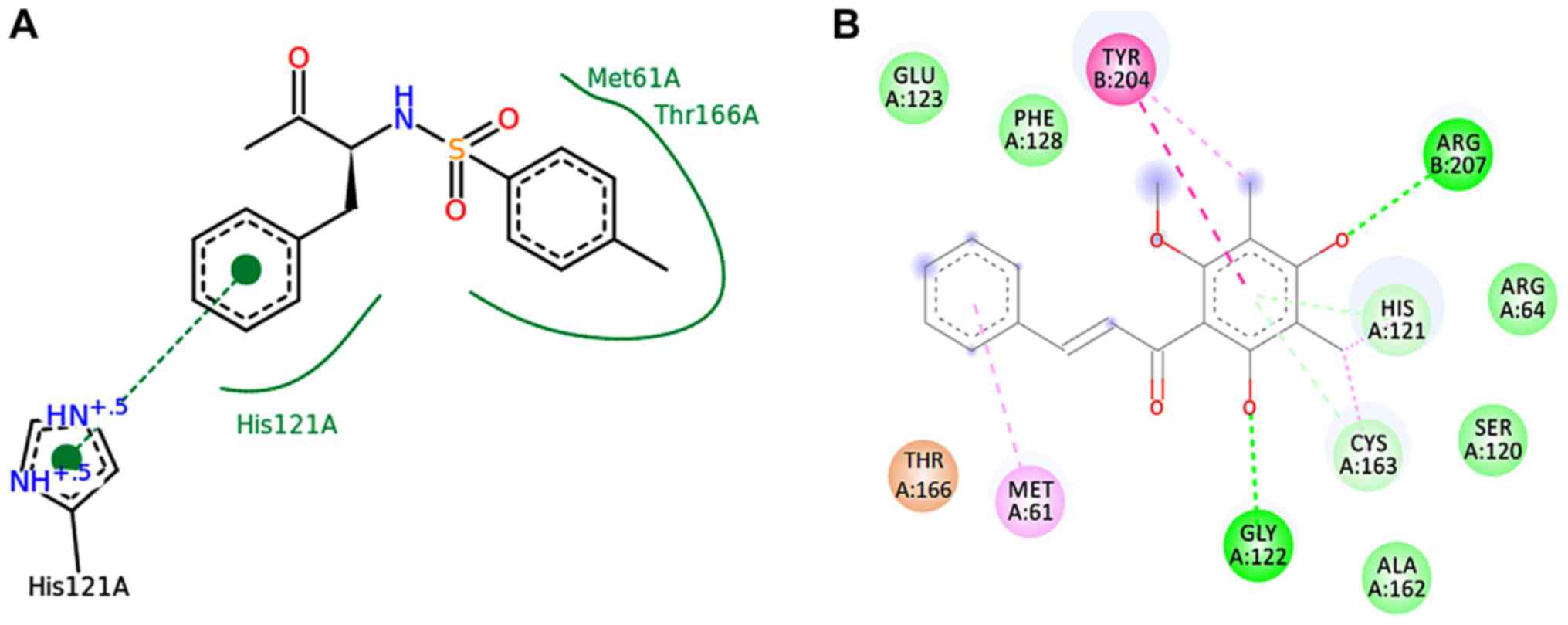|
1
|
Subarnas A, Diantini A, Abdulah R,
Zuhrotun A, Nugraha PA, Hadisaputri YE, Puspitasari IM, Yamazaki
Ch, Kuwano H and Koyama H: Apoptosis-mediated antiproliferative
activity of friedolanostane triterpenoid isolated from the leaves
of Garcinia celebica against MCF-7 human breast cancer cell lines.
Biomed Rep. 4:79–82. 2016. View Article : Google Scholar : PubMed/NCBI
|
|
2
|
Jaikumar B and Jasmine R: A Review on a
few medicinal plants possessing anticancer activity against human
breast cancer. Int J Pharm Tech Res. 9:333–365. 2016.
|
|
3
|
Ferlay J, Shin HR, Bray F, Forman D,
Mathers C and Parkin DM: Estimates of worldwide burden of cancer in
2008: GLOBOCAN 2008. Int J Cancer. 127:2893–2917. 2010. View Article : Google Scholar : PubMed/NCBI
|
|
4
|
Sakarkar DM and Deshmukh VN:
Ethnopharmacological review of traditional medicinal plants for
anticancer activity. Int J Pharm Tech Res. 3:298–308. 2011.
|
|
5
|
Kinghorn AD, Farnsworth NR, Soejarto DD,
Geoffrey AC, John MP, George OU, Mansukh CW, Monroe EW, Hernán AN,
Rob AK, et al: Novel strategies for the discovery of plant-derived
anticancer agents. Pure Appl Chem. 71:1611–1618. 1999. View Article : Google Scholar
|
|
6
|
Kinghorn AD: The role of pharmacognosy in
modern medicine. Expert Opin Pharmacother. 3:77–79. 2002.
View Article : Google Scholar : PubMed/NCBI
|
|
7
|
Kinghorn AD, Farnsworth NR, Soejarto DD,
Geoffrey AC, Steven MS, John MP, Mansukh CW, Monroe EW, Nicholas
HO, David JK, et al: Novel strategies for the discovery of
plant-derived anticancer agents. Pharm Biol. 41 (Suppl):S53–S67.
2003. View Article : Google Scholar
|
|
8
|
Diantini A, Subarnas A, Lestari K, Halimah
E, Susilawati Y, Supriyatn a, Julaeha E, Achmad TH, Suradji EW,
Yamazaki C, et al: Kaempferol-3-O-rhamnoside isolated from the
leaves of Schima wallichii Korth. inhibits MCF-7 breast cancer cell
proliferation through activation of the caspase cascade pathway.
Oncol Lett. 3:1069–1072. 2012. View Article : Google Scholar : PubMed/NCBI
|
|
9
|
Subarnas A, Diantini A, Abdulah R,
Zuhrotun A, Yamazaki C, Nakazawa M and Koyama H: Antiproliferative
activity of primates-consumed plants against MCF-7 human breast
cancer cell lines. E3 J Med Res. 1:38–43. 2012.
|
|
10
|
Subarnas A, Diantini A, Abdulah R,
Zuhrotun A, Hadisaputri YE, Puspitasari IM, Yamazaki Ch, Kuwano H
and Koyama H: Apoptosis induced in MCF-7 human breast cancer cells
by 2′,4′-dihydroxy-6-methoxy-3,5-dimethylchalcone isolated from
Eugenia aquea Burm f. leaves. Oncol Lett. 9:2303–2306. 2015.
View Article : Google Scholar : PubMed/NCBI
|
|
11
|
Bohl CE, Miller DD, Chen J, Bell CE and
Dalton JT: Structural basis for accommodation of nonsteroidal
ligands in the androgen receptor. J Biol Chem. 280:37747–37754.
2005. View Article : Google Scholar : PubMed/NCBI
|
|
12
|
Muchtaridi M, Syahidah HN, Subarnas A,
Yusuf M, Bryant SD and Langer T: Molecular docking and
3D-pharmacophore modeling to study the interactions of chalcone
derivatives with estrogen receptor alpha. Pharmaceuticals. 10:1–12.
2017. View Article : Google Scholar
|
|
13
|
Zhu XF, Xie BF, Zhou JM, Feng GK, Liu ZC,
Wei XY, Zhang FX, Liu MF and Zeng YX: Blockade of vascular
endothelial growth factor receptor signal pathway and antitumor
activity of ON-III
(2′,4′-dihydroxy-6′-methoxy-3′,5′-dimethylchalcone), a component
from Chinese herbal medicine. Mol Pharmacol. 67:1444–50. 2005.
View Article : Google Scholar : PubMed/NCBI
|
|
14
|
El-Awady RA, Hersi F, Al-Tunaiji H, Saleh
EM, Abdel-Wahab AH, Al Homssi A, Suhail M, El-Serafi A and Al-Tel
T: Epigenetics and miRNA as predictive markers and targets for lung
cancer chemotherapy. Cancer Biol Ther. 16:1056–70. 2015. View Article : Google Scholar : PubMed/NCBI
|
|
15
|
Torre LA, Bray F, Siegel RL, Ferlay J,
Lortet-Tieulent J and Jemal A: Global cancer statistics, 2012. CA
Cancer J Clin. 65:87–108. 2015. View Article : Google Scholar : PubMed/NCBI
|
|
16
|
Gutierrez RMP, Ramirez AM and Sauceda JV:
Review: Potential of chalcones as a source of drugs. Afr J Pharm
Pharmacol. 9:237–257. 2015. View Article : Google Scholar
|
|
17
|
Ye CL, Liu JW, Wei DZ, Lu YH and Qian F:
In vitro anti-tumor activity of
2′,4′-dihydroxy-6′-methoxy-3′,5′-dimethylchalcone against six
established human cancer cell lines. Pharmaco Res. 50:505–510.
2004.
|
|
18
|
Ye CL, Liu JW, Wei DZ, Lu YH and Qian F:
In vivo antitumor activity by
2′,4′-dihydroxy-6′-methoxy-3′,5′-dimethylchalcone in a solid human
carcinoma xenograft model. Cancer Chemother Pharmacol. 56:70–74.
2005. View Article : Google Scholar : PubMed/NCBI
|
|
19
|
Porter AG and Janicke RU: Emerging roles
of caspase-3 in apoptosis. Cell Death Differ. 6:99–104. 1999.
View Article : Google Scholar : PubMed/NCBI
|
|
20
|
Brentnall M, Rodriguez-Menocal L, De
Guevara RL, Cepero E and Boise LH: Caspase-9, caspase-3 and
caspase-7 have distinct roles during intrinsic apoptosis. BMC Cell
Biol. 14:32. 2013. View Article : Google Scholar : PubMed/NCBI
|
|
21
|
Ganesan R, Jelakovic S, Mittl PR, Caflisch
A and Grütter MG: In silico identification and crystal structure
validation of caspase-3 inhibitors without a P1 aspartic acid
moiety. Acta Crystallogr Sect F Struct Biol Cryst Commun.
67:842–850. 2011. View Article : Google Scholar : PubMed/NCBI
|
|
22
|
Christensen KY, Naidu A, Parent ME, Pintos
J, Abrahamowicz M, Siemiatycki J and Koushik A: The risk of lung
cancer related to dietary intake of flavonoids. Nutr Cancer.
64:964–974. 2012. View Article : Google Scholar : PubMed/NCBI
|
|
23
|
Cui Y, Morgenstern H, Greenland S, Tashkin
DP, Mao JT, Cai L, Cozen W, Mack TM, Lu QY and Zhang ZF: Dietary
flavonoid intake and lung cancer-a population-based Case-control
study. Cancer. 112:2241–2248. 2008. View Article : Google Scholar : PubMed/NCBI
|













